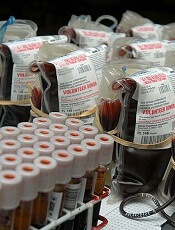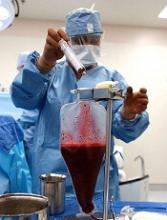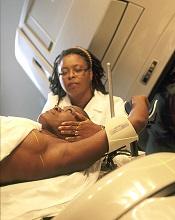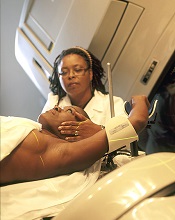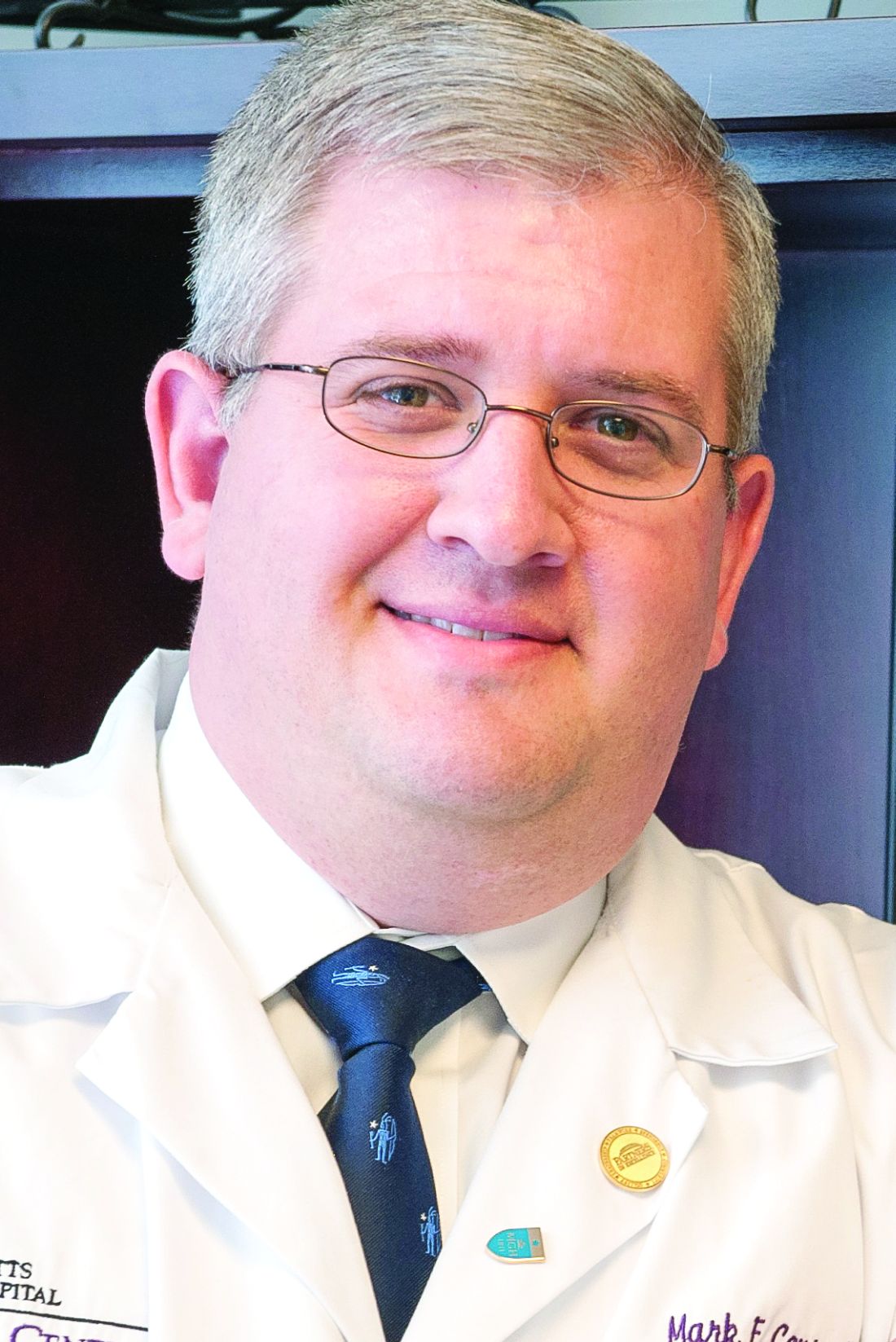User login
Genomic Analysis Reveals Surprising New Information About Cervical Cancer
Researchers from The Cancer Genome Atlas (TCGA) Research Network analyzed 178 primary cervical cancers, and found > 70% had genomic alteration in 1 or both of 2 important cell signaling pathways. They also found that a subset of tumors showed no evidence of HPV infection.
“This aspect of the research is one of the most intriguing findings to come out of the TCGA program, which has been looking at more than 30 tumor types over the past decade,” said Jean-Claude Zenklusen, PhD, director of the TCGA program office.
The researchers found several instances of amplification of genes that code for known immune targets, which may predict responsiveness to immunotherapy. They also identified several novel mutated genes. Particularly interesting, the researchers say, was the identification of a unique set of 8 cervical cancers that showed molecular similarities to endometrial cancers; the cancers were mainly HPV negative. That finding “confirms that not all cervical cancers are related to HPV infection and that a small percentage of cervical tumors may be due to strictly genetic or other factors,” said Zenklusen.
Researchers from The Cancer Genome Atlas (TCGA) Research Network analyzed 178 primary cervical cancers, and found > 70% had genomic alteration in 1 or both of 2 important cell signaling pathways. They also found that a subset of tumors showed no evidence of HPV infection.
“This aspect of the research is one of the most intriguing findings to come out of the TCGA program, which has been looking at more than 30 tumor types over the past decade,” said Jean-Claude Zenklusen, PhD, director of the TCGA program office.
The researchers found several instances of amplification of genes that code for known immune targets, which may predict responsiveness to immunotherapy. They also identified several novel mutated genes. Particularly interesting, the researchers say, was the identification of a unique set of 8 cervical cancers that showed molecular similarities to endometrial cancers; the cancers were mainly HPV negative. That finding “confirms that not all cervical cancers are related to HPV infection and that a small percentage of cervical tumors may be due to strictly genetic or other factors,” said Zenklusen.
Researchers from The Cancer Genome Atlas (TCGA) Research Network analyzed 178 primary cervical cancers, and found > 70% had genomic alteration in 1 or both of 2 important cell signaling pathways. They also found that a subset of tumors showed no evidence of HPV infection.
“This aspect of the research is one of the most intriguing findings to come out of the TCGA program, which has been looking at more than 30 tumor types over the past decade,” said Jean-Claude Zenklusen, PhD, director of the TCGA program office.
The researchers found several instances of amplification of genes that code for known immune targets, which may predict responsiveness to immunotherapy. They also identified several novel mutated genes. Particularly interesting, the researchers say, was the identification of a unique set of 8 cervical cancers that showed molecular similarities to endometrial cancers; the cancers were mainly HPV negative. That finding “confirms that not all cervical cancers are related to HPV infection and that a small percentage of cervical tumors may be due to strictly genetic or other factors,” said Zenklusen.
Donor screening assays more sensitive than diagnostic assays for Zika
New research suggests assays used to screen donated blood for the Zika virus are more sensitive than assays used to help physicians diagnose Zika infection.
The study showed that donor screening assays could detect Zika virus RNA with greater sensitivity than diagnostic real-time polymerase chain reaction (RT-PCR) assays.
However, the evidence also indicated that increasing the volume of blood analyzed can increase the sensitivity of diagnostic assays.
This research was published in Transfusion in a special issue focusing on Zika and other transfusion-transmitted viruses.
The researchers compared 17 nucleic acid amplification technology assays used at 11 different labs. (Some of the 17 assays were actually the same assays used at different labs.)
One of the donor screening assays was the Procleix Zika virus assay, which was co-developed by Hologic, Inc. and Grifols Diagnostic Solutions, Inc. and used at Hologic.
The other donor screening assay was the cobas Zika test, which was developed by Roche Molecular Systems, Inc. and used in the company’s lab.
The RT-PCR diagnostic assays included the US Centers for Disease Control and Prevention’s (CDC) Singleplex (1087, 4481) and Trioplex assays—both low input (LI) and high input (HI)—which were used at the CDC labs in Puerto Rico (PR) and Fort Collins (FC).
Modified versions of the CDC’s assays were also used at the Blood Systems Research Institute (BSRI) in San Francisco, the University of California (UC) Davis, the Institut Louis Malarde (ILM) in French Polynesia, and 2 labs in Brazil—Fundação Pró-Sangue and Laboratório Richet.
The US Food and Drug Administration (FDA) used its own RT-PCR test, and the Etablissement Francais du Sang (EFS) in France used the Altona RealStar ZIKV RT-PCR assay.
Results
The various assays were used on plasma samples positive for 2 different strains of Zika virus—1 from Brazil and 1 from French Polynesia—as well as Zika-negative control samples.
The researchers found the donor screening assays provided comparable sensitivity and were more sensitive than each of the diagnostic RT-PCR assays.
So the team compared results with the 2 donor screening assays combined to results with the RT-PCR assays, which they grouped into 9 categories based on similar intended applications, methodologies, and results.
The 95% limit of detection (LOD95) and 50% limit of detection (LOD50) for the assays were as follows.
| Donor screening assays | CDC PR Trioplex-LI | CDC PR Trioplex-HI | CDC FC 1087-LI | CDC FC 1087-HI | BSRI/UC Davis | FDA | EFS | ILM | Brazil labs | |
| Brazil LOD95 | 13.7 | 540 | 22.8 | 220 | 43.9 | 2189 | 6343 | 312 | 107 | 165 |
| Brazil LOD50 | 2.5 | 411 | 19.6 | 43.9 | 32.3 | 326 | 523 | 46.3 | 19.6 | 124 |
| French Polynesia LOD95 | 17.9 | 1529 | 28.8 | 205 | 20.3 | 1102 | 4918 | 466 | 135 | 1351 |
| French Polynesia LOD50 | 2.5 | 123 | 24.8 | 152 | 15.1 | 81.7 | 321 | 49.6 | 24.8 | 248 |
The researchers noted that the donor screening assays were about 10-fold to 100-fold more sensitive than the standard input RT-PCR assays.
However, the CDC’s assays were performed with low and high inputs of plasma. And increasing the sample input volume increased the limit of detection by 10-fold to 30-fold.
“The results of this study, that evaluated 17 Zika virus assays in 11 laboratories and documented excellent sensitivity of the 2 donor screening assays manufactured by Roche and Grifols, were critical to support the decision by the US Food and Drug Administration and blood industry to implement investigational screening of donors in Puerto Rico in April 2016 and the entire US by the end of 2016,” said study author Michael Busch, MD, PhD, of BSRI.
“Given the sensitivity of these assays, the FDA approved clinical trials using individual donation screening and rescinded earlier policies precluding transfusion of blood collected in Puerto Rico and deferral from donation by donors who had traveled to Zika risk countries throughout the US. This screening has detected over 350 infected blood donations in Puerto Rico and dozens of infected donations in the continental US.” ![]()
New research suggests assays used to screen donated blood for the Zika virus are more sensitive than assays used to help physicians diagnose Zika infection.
The study showed that donor screening assays could detect Zika virus RNA with greater sensitivity than diagnostic real-time polymerase chain reaction (RT-PCR) assays.
However, the evidence also indicated that increasing the volume of blood analyzed can increase the sensitivity of diagnostic assays.
This research was published in Transfusion in a special issue focusing on Zika and other transfusion-transmitted viruses.
The researchers compared 17 nucleic acid amplification technology assays used at 11 different labs. (Some of the 17 assays were actually the same assays used at different labs.)
One of the donor screening assays was the Procleix Zika virus assay, which was co-developed by Hologic, Inc. and Grifols Diagnostic Solutions, Inc. and used at Hologic.
The other donor screening assay was the cobas Zika test, which was developed by Roche Molecular Systems, Inc. and used in the company’s lab.
The RT-PCR diagnostic assays included the US Centers for Disease Control and Prevention’s (CDC) Singleplex (1087, 4481) and Trioplex assays—both low input (LI) and high input (HI)—which were used at the CDC labs in Puerto Rico (PR) and Fort Collins (FC).
Modified versions of the CDC’s assays were also used at the Blood Systems Research Institute (BSRI) in San Francisco, the University of California (UC) Davis, the Institut Louis Malarde (ILM) in French Polynesia, and 2 labs in Brazil—Fundação Pró-Sangue and Laboratório Richet.
The US Food and Drug Administration (FDA) used its own RT-PCR test, and the Etablissement Francais du Sang (EFS) in France used the Altona RealStar ZIKV RT-PCR assay.
Results
The various assays were used on plasma samples positive for 2 different strains of Zika virus—1 from Brazil and 1 from French Polynesia—as well as Zika-negative control samples.
The researchers found the donor screening assays provided comparable sensitivity and were more sensitive than each of the diagnostic RT-PCR assays.
So the team compared results with the 2 donor screening assays combined to results with the RT-PCR assays, which they grouped into 9 categories based on similar intended applications, methodologies, and results.
The 95% limit of detection (LOD95) and 50% limit of detection (LOD50) for the assays were as follows.
| Donor screening assays | CDC PR Trioplex-LI | CDC PR Trioplex-HI | CDC FC 1087-LI | CDC FC 1087-HI | BSRI/UC Davis | FDA | EFS | ILM | Brazil labs | |
| Brazil LOD95 | 13.7 | 540 | 22.8 | 220 | 43.9 | 2189 | 6343 | 312 | 107 | 165 |
| Brazil LOD50 | 2.5 | 411 | 19.6 | 43.9 | 32.3 | 326 | 523 | 46.3 | 19.6 | 124 |
| French Polynesia LOD95 | 17.9 | 1529 | 28.8 | 205 | 20.3 | 1102 | 4918 | 466 | 135 | 1351 |
| French Polynesia LOD50 | 2.5 | 123 | 24.8 | 152 | 15.1 | 81.7 | 321 | 49.6 | 24.8 | 248 |
The researchers noted that the donor screening assays were about 10-fold to 100-fold more sensitive than the standard input RT-PCR assays.
However, the CDC’s assays were performed with low and high inputs of plasma. And increasing the sample input volume increased the limit of detection by 10-fold to 30-fold.
“The results of this study, that evaluated 17 Zika virus assays in 11 laboratories and documented excellent sensitivity of the 2 donor screening assays manufactured by Roche and Grifols, were critical to support the decision by the US Food and Drug Administration and blood industry to implement investigational screening of donors in Puerto Rico in April 2016 and the entire US by the end of 2016,” said study author Michael Busch, MD, PhD, of BSRI.
“Given the sensitivity of these assays, the FDA approved clinical trials using individual donation screening and rescinded earlier policies precluding transfusion of blood collected in Puerto Rico and deferral from donation by donors who had traveled to Zika risk countries throughout the US. This screening has detected over 350 infected blood donations in Puerto Rico and dozens of infected donations in the continental US.” ![]()
New research suggests assays used to screen donated blood for the Zika virus are more sensitive than assays used to help physicians diagnose Zika infection.
The study showed that donor screening assays could detect Zika virus RNA with greater sensitivity than diagnostic real-time polymerase chain reaction (RT-PCR) assays.
However, the evidence also indicated that increasing the volume of blood analyzed can increase the sensitivity of diagnostic assays.
This research was published in Transfusion in a special issue focusing on Zika and other transfusion-transmitted viruses.
The researchers compared 17 nucleic acid amplification technology assays used at 11 different labs. (Some of the 17 assays were actually the same assays used at different labs.)
One of the donor screening assays was the Procleix Zika virus assay, which was co-developed by Hologic, Inc. and Grifols Diagnostic Solutions, Inc. and used at Hologic.
The other donor screening assay was the cobas Zika test, which was developed by Roche Molecular Systems, Inc. and used in the company’s lab.
The RT-PCR diagnostic assays included the US Centers for Disease Control and Prevention’s (CDC) Singleplex (1087, 4481) and Trioplex assays—both low input (LI) and high input (HI)—which were used at the CDC labs in Puerto Rico (PR) and Fort Collins (FC).
Modified versions of the CDC’s assays were also used at the Blood Systems Research Institute (BSRI) in San Francisco, the University of California (UC) Davis, the Institut Louis Malarde (ILM) in French Polynesia, and 2 labs in Brazil—Fundação Pró-Sangue and Laboratório Richet.
The US Food and Drug Administration (FDA) used its own RT-PCR test, and the Etablissement Francais du Sang (EFS) in France used the Altona RealStar ZIKV RT-PCR assay.
Results
The various assays were used on plasma samples positive for 2 different strains of Zika virus—1 from Brazil and 1 from French Polynesia—as well as Zika-negative control samples.
The researchers found the donor screening assays provided comparable sensitivity and were more sensitive than each of the diagnostic RT-PCR assays.
So the team compared results with the 2 donor screening assays combined to results with the RT-PCR assays, which they grouped into 9 categories based on similar intended applications, methodologies, and results.
The 95% limit of detection (LOD95) and 50% limit of detection (LOD50) for the assays were as follows.
| Donor screening assays | CDC PR Trioplex-LI | CDC PR Trioplex-HI | CDC FC 1087-LI | CDC FC 1087-HI | BSRI/UC Davis | FDA | EFS | ILM | Brazil labs | |
| Brazil LOD95 | 13.7 | 540 | 22.8 | 220 | 43.9 | 2189 | 6343 | 312 | 107 | 165 |
| Brazil LOD50 | 2.5 | 411 | 19.6 | 43.9 | 32.3 | 326 | 523 | 46.3 | 19.6 | 124 |
| French Polynesia LOD95 | 17.9 | 1529 | 28.8 | 205 | 20.3 | 1102 | 4918 | 466 | 135 | 1351 |
| French Polynesia LOD50 | 2.5 | 123 | 24.8 | 152 | 15.1 | 81.7 | 321 | 49.6 | 24.8 | 248 |
The researchers noted that the donor screening assays were about 10-fold to 100-fold more sensitive than the standard input RT-PCR assays.
However, the CDC’s assays were performed with low and high inputs of plasma. And increasing the sample input volume increased the limit of detection by 10-fold to 30-fold.
“The results of this study, that evaluated 17 Zika virus assays in 11 laboratories and documented excellent sensitivity of the 2 donor screening assays manufactured by Roche and Grifols, were critical to support the decision by the US Food and Drug Administration and blood industry to implement investigational screening of donors in Puerto Rico in April 2016 and the entire US by the end of 2016,” said study author Michael Busch, MD, PhD, of BSRI.
“Given the sensitivity of these assays, the FDA approved clinical trials using individual donation screening and rescinded earlier policies precluding transfusion of blood collected in Puerto Rico and deferral from donation by donors who had traveled to Zika risk countries throughout the US. This screening has detected over 350 infected blood donations in Puerto Rico and dozens of infected donations in the continental US.” ![]()
Drug induces remission in patient with severe TA-TMA
MARSEILLE—An investigational drug has successfully treated a severe case of transplant-associated thrombotic microangiopathy (TA-TMA), according to a presentation at the 43rd Annual Meeting of the European Society for Blood and Marrow Transplantation.
The drug is OMS721, a monoclonal antibody targeting mannan-binding lectin-associated serine protease-2 (MASP-2), the effector enzyme of the lectin pathway of the complement system.
The patient received OMS721, which is being developed by Omeros Corporation, under a compassionate-use protocol.
Marco Zecca, MD, of the Fondazione IRCCS Policlinico San Matteo in Italy, and his colleagues provided details on this patient in a poster presented at the meeting (Physician Poster Abstracts-Day 1, abstract A437).
The female patient had undergone a hematopoietic stem cell transplant to treat Diamond‐Blackfan anemia. At age 14, she received a transplant from an HLA-compatible, unrelated donor.
Seven months later, she was diagnosed with TA-TMA. The patient was initially treated with eculizumab but had to stop taking the drug after she developed acute pulmonary edema.
She was then treated with plasma exchange but experienced a TA-TMA relapse at 11 months. The patient was again treated with eculizumab and again had to discontinue the drug after developing acute pulmonary edema.
The patient’s condition continued to worsen, and she soon required hemodialysis 3 times a week as well as daily platelet transfusions.
Dr Zecca requested OMS721 as compassionate-use treatment for the patient, and Omeros complied.
Two months after starting OMS721, the patient was able to discontinue hemodialysis and decrease her platelet transfusion requirements. She did not experience any adverse events related to OMS721.
Recently, the patient’s dose was tapered, but she developed a viral infection that reactivated her TA-TMA.
A return to the original dose of OMS721 was successful. Now, the patient no longer requires dialysis or transfusions.
“This patient had severe TMA that I believe would have caused her death,” Dr Zecca said. “Her positive response to OMS721 treatment, both initially and following her virus-induced relapse during tapering, was impressive.”
“The results of OMS721 treatment in this challenge-rechallenge scenario underscore the important effects of the drug. Since the poster was produced, her TMA has remained in remission, and we have been able to discontinue her platelet transfusions. Her rapid response has been heartening, and we all are grateful for this remarkable outcome.” ![]()
MARSEILLE—An investigational drug has successfully treated a severe case of transplant-associated thrombotic microangiopathy (TA-TMA), according to a presentation at the 43rd Annual Meeting of the European Society for Blood and Marrow Transplantation.
The drug is OMS721, a monoclonal antibody targeting mannan-binding lectin-associated serine protease-2 (MASP-2), the effector enzyme of the lectin pathway of the complement system.
The patient received OMS721, which is being developed by Omeros Corporation, under a compassionate-use protocol.
Marco Zecca, MD, of the Fondazione IRCCS Policlinico San Matteo in Italy, and his colleagues provided details on this patient in a poster presented at the meeting (Physician Poster Abstracts-Day 1, abstract A437).
The female patient had undergone a hematopoietic stem cell transplant to treat Diamond‐Blackfan anemia. At age 14, she received a transplant from an HLA-compatible, unrelated donor.
Seven months later, she was diagnosed with TA-TMA. The patient was initially treated with eculizumab but had to stop taking the drug after she developed acute pulmonary edema.
She was then treated with plasma exchange but experienced a TA-TMA relapse at 11 months. The patient was again treated with eculizumab and again had to discontinue the drug after developing acute pulmonary edema.
The patient’s condition continued to worsen, and she soon required hemodialysis 3 times a week as well as daily platelet transfusions.
Dr Zecca requested OMS721 as compassionate-use treatment for the patient, and Omeros complied.
Two months after starting OMS721, the patient was able to discontinue hemodialysis and decrease her platelet transfusion requirements. She did not experience any adverse events related to OMS721.
Recently, the patient’s dose was tapered, but she developed a viral infection that reactivated her TA-TMA.
A return to the original dose of OMS721 was successful. Now, the patient no longer requires dialysis or transfusions.
“This patient had severe TMA that I believe would have caused her death,” Dr Zecca said. “Her positive response to OMS721 treatment, both initially and following her virus-induced relapse during tapering, was impressive.”
“The results of OMS721 treatment in this challenge-rechallenge scenario underscore the important effects of the drug. Since the poster was produced, her TMA has remained in remission, and we have been able to discontinue her platelet transfusions. Her rapid response has been heartening, and we all are grateful for this remarkable outcome.” ![]()
MARSEILLE—An investigational drug has successfully treated a severe case of transplant-associated thrombotic microangiopathy (TA-TMA), according to a presentation at the 43rd Annual Meeting of the European Society for Blood and Marrow Transplantation.
The drug is OMS721, a monoclonal antibody targeting mannan-binding lectin-associated serine protease-2 (MASP-2), the effector enzyme of the lectin pathway of the complement system.
The patient received OMS721, which is being developed by Omeros Corporation, under a compassionate-use protocol.
Marco Zecca, MD, of the Fondazione IRCCS Policlinico San Matteo in Italy, and his colleagues provided details on this patient in a poster presented at the meeting (Physician Poster Abstracts-Day 1, abstract A437).
The female patient had undergone a hematopoietic stem cell transplant to treat Diamond‐Blackfan anemia. At age 14, she received a transplant from an HLA-compatible, unrelated donor.
Seven months later, she was diagnosed with TA-TMA. The patient was initially treated with eculizumab but had to stop taking the drug after she developed acute pulmonary edema.
She was then treated with plasma exchange but experienced a TA-TMA relapse at 11 months. The patient was again treated with eculizumab and again had to discontinue the drug after developing acute pulmonary edema.
The patient’s condition continued to worsen, and she soon required hemodialysis 3 times a week as well as daily platelet transfusions.
Dr Zecca requested OMS721 as compassionate-use treatment for the patient, and Omeros complied.
Two months after starting OMS721, the patient was able to discontinue hemodialysis and decrease her platelet transfusion requirements. She did not experience any adverse events related to OMS721.
Recently, the patient’s dose was tapered, but she developed a viral infection that reactivated her TA-TMA.
A return to the original dose of OMS721 was successful. Now, the patient no longer requires dialysis or transfusions.
“This patient had severe TMA that I believe would have caused her death,” Dr Zecca said. “Her positive response to OMS721 treatment, both initially and following her virus-induced relapse during tapering, was impressive.”
“The results of OMS721 treatment in this challenge-rechallenge scenario underscore the important effects of the drug. Since the poster was produced, her TMA has remained in remission, and we have been able to discontinue her platelet transfusions. Her rapid response has been heartening, and we all are grateful for this remarkable outcome.” ![]()
NCCN launches radiation therapy resource
The National Comprehensive Cancer Network® (NCCN®) recently launched the NCCN Radiation Therapy Compendium™, which provides a single access point for NCCN recommendations pertaining to radiation therapy.
The compendium provides guidance on all radiation therapy modalities recommended within NCCN guidelines, including intensity modulated radiation therapy, intra-operative radiation therapy, stereotactic radiosurgery/stereotactic body radiotherapy/stereotactic ablative radiotherapy, image-guided radiotherapy, low dose-rate brachytherapy/high dose-rate brachytherapy, radioisotope, and particle therapy.
“As a single source for all radiation therapy recommendations within the NCCN guidelines, the compendium benefits patients with cancer by assisting providers and payers in making evidence-based treatment and coverage decisions,” said Robert W. Carlson, MD, chief executive officer of NCCN.
The NCCN Radiation Therapy Compendium™ includes recommendations for the following 24 cancer types:
Acute myeloid leukemia
Anal cancer
B-cell lymphomas
Bladder cancer
Breast cancer
Chronic lymphocytic leukemia/small lymphoblastic lymphoma
Colon cancer
Hepatobiliary cancers
Kidney cancer
Malignant pleural mesothelioma
Melanoma
Multiple myeloma
Neuroendocrine tumors
Non-small cell lung cancer
Occult primary cancer
Pancreatic adenocarcinoma
Penile cancer
Primary cutaneous B-cell lymphomas
Prostate cancer
Rectal cancer
Small cell lung cancer
Soft tissue sarcoma
T-cell lymphomas
Testicular cancer
NCCN said additional cancer types will be published on a rolling basis over the coming months. ![]()
The National Comprehensive Cancer Network® (NCCN®) recently launched the NCCN Radiation Therapy Compendium™, which provides a single access point for NCCN recommendations pertaining to radiation therapy.
The compendium provides guidance on all radiation therapy modalities recommended within NCCN guidelines, including intensity modulated radiation therapy, intra-operative radiation therapy, stereotactic radiosurgery/stereotactic body radiotherapy/stereotactic ablative radiotherapy, image-guided radiotherapy, low dose-rate brachytherapy/high dose-rate brachytherapy, radioisotope, and particle therapy.
“As a single source for all radiation therapy recommendations within the NCCN guidelines, the compendium benefits patients with cancer by assisting providers and payers in making evidence-based treatment and coverage decisions,” said Robert W. Carlson, MD, chief executive officer of NCCN.
The NCCN Radiation Therapy Compendium™ includes recommendations for the following 24 cancer types:
Acute myeloid leukemia
Anal cancer
B-cell lymphomas
Bladder cancer
Breast cancer
Chronic lymphocytic leukemia/small lymphoblastic lymphoma
Colon cancer
Hepatobiliary cancers
Kidney cancer
Malignant pleural mesothelioma
Melanoma
Multiple myeloma
Neuroendocrine tumors
Non-small cell lung cancer
Occult primary cancer
Pancreatic adenocarcinoma
Penile cancer
Primary cutaneous B-cell lymphomas
Prostate cancer
Rectal cancer
Small cell lung cancer
Soft tissue sarcoma
T-cell lymphomas
Testicular cancer
NCCN said additional cancer types will be published on a rolling basis over the coming months. ![]()
The National Comprehensive Cancer Network® (NCCN®) recently launched the NCCN Radiation Therapy Compendium™, which provides a single access point for NCCN recommendations pertaining to radiation therapy.
The compendium provides guidance on all radiation therapy modalities recommended within NCCN guidelines, including intensity modulated radiation therapy, intra-operative radiation therapy, stereotactic radiosurgery/stereotactic body radiotherapy/stereotactic ablative radiotherapy, image-guided radiotherapy, low dose-rate brachytherapy/high dose-rate brachytherapy, radioisotope, and particle therapy.
“As a single source for all radiation therapy recommendations within the NCCN guidelines, the compendium benefits patients with cancer by assisting providers and payers in making evidence-based treatment and coverage decisions,” said Robert W. Carlson, MD, chief executive officer of NCCN.
The NCCN Radiation Therapy Compendium™ includes recommendations for the following 24 cancer types:
Acute myeloid leukemia
Anal cancer
B-cell lymphomas
Bladder cancer
Breast cancer
Chronic lymphocytic leukemia/small lymphoblastic lymphoma
Colon cancer
Hepatobiliary cancers
Kidney cancer
Malignant pleural mesothelioma
Melanoma
Multiple myeloma
Neuroendocrine tumors
Non-small cell lung cancer
Occult primary cancer
Pancreatic adenocarcinoma
Penile cancer
Primary cutaneous B-cell lymphomas
Prostate cancer
Rectal cancer
Small cell lung cancer
Soft tissue sarcoma
T-cell lymphomas
Testicular cancer
NCCN said additional cancer types will be published on a rolling basis over the coming months. ![]()
Drug receives orphan designation for AML
The US Food and Drug Administration (FDA) has granted annamycin orphan designation for the treatment of acute myeloid leukemia (AML).
Annamycin is a liposomal anthracycline under development by Moleculin Biotech, Inc.
The company said it is working with the FDA on an investigative new drug application for a phase 1/2 trial of annamycin in patients with relapsed or refractory AML.
Annamycin has already been tested in 6 clinical trials, 3 of which focused on leukemia.
Results from one of these trials, in adults with relapsed/refractory acute lymphoblastic leukemia, were published in Clinical Lymphoma, Myeloma & Leukemia in 2013.
Annamycin has been under development by several other pharmaceutical companies. Moleculin Biotech, Inc. acquired rights and development assets relating to the drug in 2015.
About orphan designation
The FDA grants orphan designation to drugs and biologics intended to treat, diagnose, or prevent rare diseases/disorders affecting fewer than 200,000 people in the US.
Orphan designation provides companies with certain incentives to develop products for rare diseases. This includes a 50% tax break on research and development, a fee waiver, access to federal grants, and 7 years of market exclusivity if the product is approved. ![]()
The US Food and Drug Administration (FDA) has granted annamycin orphan designation for the treatment of acute myeloid leukemia (AML).
Annamycin is a liposomal anthracycline under development by Moleculin Biotech, Inc.
The company said it is working with the FDA on an investigative new drug application for a phase 1/2 trial of annamycin in patients with relapsed or refractory AML.
Annamycin has already been tested in 6 clinical trials, 3 of which focused on leukemia.
Results from one of these trials, in adults with relapsed/refractory acute lymphoblastic leukemia, were published in Clinical Lymphoma, Myeloma & Leukemia in 2013.
Annamycin has been under development by several other pharmaceutical companies. Moleculin Biotech, Inc. acquired rights and development assets relating to the drug in 2015.
About orphan designation
The FDA grants orphan designation to drugs and biologics intended to treat, diagnose, or prevent rare diseases/disorders affecting fewer than 200,000 people in the US.
Orphan designation provides companies with certain incentives to develop products for rare diseases. This includes a 50% tax break on research and development, a fee waiver, access to federal grants, and 7 years of market exclusivity if the product is approved. ![]()
The US Food and Drug Administration (FDA) has granted annamycin orphan designation for the treatment of acute myeloid leukemia (AML).
Annamycin is a liposomal anthracycline under development by Moleculin Biotech, Inc.
The company said it is working with the FDA on an investigative new drug application for a phase 1/2 trial of annamycin in patients with relapsed or refractory AML.
Annamycin has already been tested in 6 clinical trials, 3 of which focused on leukemia.
Results from one of these trials, in adults with relapsed/refractory acute lymphoblastic leukemia, were published in Clinical Lymphoma, Myeloma & Leukemia in 2013.
Annamycin has been under development by several other pharmaceutical companies. Moleculin Biotech, Inc. acquired rights and development assets relating to the drug in 2015.
About orphan designation
The FDA grants orphan designation to drugs and biologics intended to treat, diagnose, or prevent rare diseases/disorders affecting fewer than 200,000 people in the US.
Orphan designation provides companies with certain incentives to develop products for rare diseases. This includes a 50% tax break on research and development, a fee waiver, access to federal grants, and 7 years of market exclusivity if the product is approved. ![]()
Childhood adiposity tied to NAFLD and elevated ALT in adulthood
Overweight or obese children in a cohort study were more likely to have adult nonalcoholic fatty liver disease (NAFLD) and elevated levels of the liver enzyme alanine aminotransferase than were healthy weight children of both sexes, but this association can be mitigated by weight loss in adulthood.
“These findings underscore the importance of both early prevention and lifelong treatment of overweight and obesity to reduce the risk of adverse liver outcome in adulthood,” Yinkun Yan, PhD, an epidemiologist at the Capital Institute of Pediatrics, Beijing, and associates wrote (Pediatrics. 2017;139[4]:e20162738).
The adiposity of the children was determined by caliper measurements and body mass index. ALT elevation was diagnosed via blood tests and NAFLD from ultrasonography. ALT is considered to be the most specific marker of liver damage, and NAFLD is one of the most common causes of liver disease worldwide.
Children who were overweight or obese were more likely to grow up to have elevated ALT levels (40% vs. 30% in men and 23% vs. 12% in women) or NAFLD (62% vs. 39% in men and 39% vs. 15% in women) than were healthy weight children. Obesity in adulthood was a higher risk whether a participant was obese as a child or not, but the researchers noted that risks could be mitigated by acquiring normal weight in adulthood.
Overweight or obese children in a cohort study were more likely to have adult nonalcoholic fatty liver disease (NAFLD) and elevated levels of the liver enzyme alanine aminotransferase than were healthy weight children of both sexes, but this association can be mitigated by weight loss in adulthood.
“These findings underscore the importance of both early prevention and lifelong treatment of overweight and obesity to reduce the risk of adverse liver outcome in adulthood,” Yinkun Yan, PhD, an epidemiologist at the Capital Institute of Pediatrics, Beijing, and associates wrote (Pediatrics. 2017;139[4]:e20162738).
The adiposity of the children was determined by caliper measurements and body mass index. ALT elevation was diagnosed via blood tests and NAFLD from ultrasonography. ALT is considered to be the most specific marker of liver damage, and NAFLD is one of the most common causes of liver disease worldwide.
Children who were overweight or obese were more likely to grow up to have elevated ALT levels (40% vs. 30% in men and 23% vs. 12% in women) or NAFLD (62% vs. 39% in men and 39% vs. 15% in women) than were healthy weight children. Obesity in adulthood was a higher risk whether a participant was obese as a child or not, but the researchers noted that risks could be mitigated by acquiring normal weight in adulthood.
Overweight or obese children in a cohort study were more likely to have adult nonalcoholic fatty liver disease (NAFLD) and elevated levels of the liver enzyme alanine aminotransferase than were healthy weight children of both sexes, but this association can be mitigated by weight loss in adulthood.
“These findings underscore the importance of both early prevention and lifelong treatment of overweight and obesity to reduce the risk of adverse liver outcome in adulthood,” Yinkun Yan, PhD, an epidemiologist at the Capital Institute of Pediatrics, Beijing, and associates wrote (Pediatrics. 2017;139[4]:e20162738).
The adiposity of the children was determined by caliper measurements and body mass index. ALT elevation was diagnosed via blood tests and NAFLD from ultrasonography. ALT is considered to be the most specific marker of liver damage, and NAFLD is one of the most common causes of liver disease worldwide.
Children who were overweight or obese were more likely to grow up to have elevated ALT levels (40% vs. 30% in men and 23% vs. 12% in women) or NAFLD (62% vs. 39% in men and 39% vs. 15% in women) than were healthy weight children. Obesity in adulthood was a higher risk whether a participant was obese as a child or not, but the researchers noted that risks could be mitigated by acquiring normal weight in adulthood.
Men’s Health and Endocrinology: Testosterone Replacement Therapy
Observation works for most smaller splanchnic artery aneurysms
CHICAGO – Guidelines for the management of splanchnic artery aneurysms have been hard to come by because of their rarity, but investigators at Massachusetts General Hospital and Harvard Medical School, both in Boston, have surveyed their 20-year experience to conclude that surveillance is appropriate for most cases of aneurysms smaller than 25 mm, and selective open or endovascular repair is indicated for larger lesions, depending on their location.
“Most of the small splanchnic artery aneurysms (SAAs) of less than 25 mm did not grow or rupture over time and can be observed with axial imaging every 3 years,” Mark F. Conrad, MD, reported at a symposium on vascular surgery sponsored by Northwestern University.
The predominant sites of aneurysm were the splenic artery (95, 36%) and the celiac artery (78, 30%), followed by the hepatic artery (34, 13%), pancreaticoduodenal artery (PDA; 25, 9.6%), superior mesenteric artery (SMA; 17, 6%), gastroduodenal artery (GDA; 11, 4%), jejunal artery (3, 1%) and inferior mesenteric artery (1, 0.4%).
Surveillance consisted of imaging every 3 years. Of the surveillance cohort, 138 patients had longer-term follow-up. The average aneurysm size was 16.3 mm, “so they’re small,” Dr. Conrad said. Of that whole group, only 12 (9%), of SAAs grew in size, and of those, 8 were 25 mm or smaller when they were identified; 8 of the 12 required repair. “The average time to repair was 2 years,” Dr. Conrad said. “There were no ruptures in the surveillance cohort.”
Among the early repair group, 13 (14.7%) had rupture upon presentation, 3 of which (23%) were pseudoaneurysms. The majority of aneurysms in this group were in either the splenic artery, PDA, or GDA. “Their average size was 31 mm – much larger than the patients that we watched,” he said. A total of 70% of all repairs were endovascular in nature, the remainder open, but endovascular comprised a higher percentage of rupture repairs: 10 (77%) vs. 3 (23%) that underwent open procedures.
The outcomes for endovascular and open repair were similar based on the small number of subjects, Dr. Conrad said: 30-day morbidity of 17% for endovascular repair and 22.2% for open; and 30-day mortality of 3.5% and 4.5%, respectively. However, for ruptured lesions, the outcomes were starkly significant: 54% morbidity and 8% mortality at 30 days.
The researchers performed a univariate analysis of predictors for aneurysm. They were aneurysm size with an odds ratio of 1.04 for every 1 mm of growth; PDA or GDA lesions with an OR of 11.2; and Ehlers-Danlos type IV syndrome with an OR of 32.5. The latter included all the three study patients with Ehlers-Danlos syndrome.
Among patients who had splenic SAAs, 99 (93%) were asymptomatic and 5 (5.3%) had pseudoaneurysm, and almost half (47) went into surveillance. Over a mean observation period of 35 months, six (12.8%) grew in size, comprising half of the growing SAAs in the observation group. Thirty-two had endovascular repair and four open repair, with a 30-day morbidity of 22% and 30-day mortality of 2.7%.
Celiac SAAs proved most problematic in terms of symptomatology; all 78 patients with this variant were asymptomatic, and 12 (15%) had dissection. Sixty patients went into surveillance with a mean time of 43 months, and three (5) had aneurysms that grew in size. Five had intervention, four with open repair, with 30-day morbidity of 20% and no 30-day mortality.
Hepatic SAAs affected 34 study subjects, 29 (85%) of whom were asymptomatic, 4 (15%) who had dissection, and 7 (21%) with pseudoaneurysm. Eleven entered surveillance for an average of 28 months, but none showed any aneurysmal growth. The 16 who had intervention were evenly split between open and endovascular repair with 30-day morbidity of 25% and 30-day morality of 12.5%.
The PDA and GDA aneurysms “are really interesting,” Dr. Conrad said. “I think they’re different in nature than the other aneurysms,” he said, noting that 12 (33%) of these aneurysms were symptomatic and 6 (17%) were pseudoaneurysms. Because of the high rate of rupture of PDA/GDA aneurysms, Dr. Conrad advised repair at diagnosis: “97% of these patients had a celiac stenosis, and of those, two-thirds were atherosclerosis related and one-third related to the median arcuate ligament compression.” The rupture rate was comparatively high – 20%. Twenty cases underwent endovascular repair with a 90% success rate while four cases had open repair. Thirty-day morbidity for intact lesions was 11% with no deaths, and 50% with 14% mortality rate for ruptured lesions.
Of the SMA aneurysms in the study population, only 17% were mycotic with the remainder asymptomatic, Dr. Conrad said. Nine underwent surveillance, with one growing in size over a mean observation period of 28 months, four had open repair, and two endovascular repair. Morbidity was 17% at 30 days with no deaths.
The guidelines Dr. Conrad and his group developed recommend treatment for symptomatic patients and a more nuanced approach for asymptomatic patients, depending on the location and size of SAA. All lesions 25 mm or smaller, except those of the PDA/GDA, can be observed with axial imaging every 3 years, he said; intervention is indicated for all larger lesions. Endovascular repair is in order for all splenic SAAs in pregnancy, liver transplantation, and pseudoaneurysm. For hepatic SAAs, open or endovascular repair is indicated for pseudoaneurysm, but open repair only is indicated for asymptomatic celiac SAAs with pseudoaneurysm. Endovascular intervention can address most SAA aneurysms of the PDA and GDA.
Dr. Conrad disclosed he is a consultant to Medtronic and Volcano and is a member of Bard’s clinical events committee.
CHICAGO – Guidelines for the management of splanchnic artery aneurysms have been hard to come by because of their rarity, but investigators at Massachusetts General Hospital and Harvard Medical School, both in Boston, have surveyed their 20-year experience to conclude that surveillance is appropriate for most cases of aneurysms smaller than 25 mm, and selective open or endovascular repair is indicated for larger lesions, depending on their location.
“Most of the small splanchnic artery aneurysms (SAAs) of less than 25 mm did not grow or rupture over time and can be observed with axial imaging every 3 years,” Mark F. Conrad, MD, reported at a symposium on vascular surgery sponsored by Northwestern University.
The predominant sites of aneurysm were the splenic artery (95, 36%) and the celiac artery (78, 30%), followed by the hepatic artery (34, 13%), pancreaticoduodenal artery (PDA; 25, 9.6%), superior mesenteric artery (SMA; 17, 6%), gastroduodenal artery (GDA; 11, 4%), jejunal artery (3, 1%) and inferior mesenteric artery (1, 0.4%).
Surveillance consisted of imaging every 3 years. Of the surveillance cohort, 138 patients had longer-term follow-up. The average aneurysm size was 16.3 mm, “so they’re small,” Dr. Conrad said. Of that whole group, only 12 (9%), of SAAs grew in size, and of those, 8 were 25 mm or smaller when they were identified; 8 of the 12 required repair. “The average time to repair was 2 years,” Dr. Conrad said. “There were no ruptures in the surveillance cohort.”
Among the early repair group, 13 (14.7%) had rupture upon presentation, 3 of which (23%) were pseudoaneurysms. The majority of aneurysms in this group were in either the splenic artery, PDA, or GDA. “Their average size was 31 mm – much larger than the patients that we watched,” he said. A total of 70% of all repairs were endovascular in nature, the remainder open, but endovascular comprised a higher percentage of rupture repairs: 10 (77%) vs. 3 (23%) that underwent open procedures.
The outcomes for endovascular and open repair were similar based on the small number of subjects, Dr. Conrad said: 30-day morbidity of 17% for endovascular repair and 22.2% for open; and 30-day mortality of 3.5% and 4.5%, respectively. However, for ruptured lesions, the outcomes were starkly significant: 54% morbidity and 8% mortality at 30 days.
The researchers performed a univariate analysis of predictors for aneurysm. They were aneurysm size with an odds ratio of 1.04 for every 1 mm of growth; PDA or GDA lesions with an OR of 11.2; and Ehlers-Danlos type IV syndrome with an OR of 32.5. The latter included all the three study patients with Ehlers-Danlos syndrome.
Among patients who had splenic SAAs, 99 (93%) were asymptomatic and 5 (5.3%) had pseudoaneurysm, and almost half (47) went into surveillance. Over a mean observation period of 35 months, six (12.8%) grew in size, comprising half of the growing SAAs in the observation group. Thirty-two had endovascular repair and four open repair, with a 30-day morbidity of 22% and 30-day mortality of 2.7%.
Celiac SAAs proved most problematic in terms of symptomatology; all 78 patients with this variant were asymptomatic, and 12 (15%) had dissection. Sixty patients went into surveillance with a mean time of 43 months, and three (5) had aneurysms that grew in size. Five had intervention, four with open repair, with 30-day morbidity of 20% and no 30-day mortality.
Hepatic SAAs affected 34 study subjects, 29 (85%) of whom were asymptomatic, 4 (15%) who had dissection, and 7 (21%) with pseudoaneurysm. Eleven entered surveillance for an average of 28 months, but none showed any aneurysmal growth. The 16 who had intervention were evenly split between open and endovascular repair with 30-day morbidity of 25% and 30-day morality of 12.5%.
The PDA and GDA aneurysms “are really interesting,” Dr. Conrad said. “I think they’re different in nature than the other aneurysms,” he said, noting that 12 (33%) of these aneurysms were symptomatic and 6 (17%) were pseudoaneurysms. Because of the high rate of rupture of PDA/GDA aneurysms, Dr. Conrad advised repair at diagnosis: “97% of these patients had a celiac stenosis, and of those, two-thirds were atherosclerosis related and one-third related to the median arcuate ligament compression.” The rupture rate was comparatively high – 20%. Twenty cases underwent endovascular repair with a 90% success rate while four cases had open repair. Thirty-day morbidity for intact lesions was 11% with no deaths, and 50% with 14% mortality rate for ruptured lesions.
Of the SMA aneurysms in the study population, only 17% were mycotic with the remainder asymptomatic, Dr. Conrad said. Nine underwent surveillance, with one growing in size over a mean observation period of 28 months, four had open repair, and two endovascular repair. Morbidity was 17% at 30 days with no deaths.
The guidelines Dr. Conrad and his group developed recommend treatment for symptomatic patients and a more nuanced approach for asymptomatic patients, depending on the location and size of SAA. All lesions 25 mm or smaller, except those of the PDA/GDA, can be observed with axial imaging every 3 years, he said; intervention is indicated for all larger lesions. Endovascular repair is in order for all splenic SAAs in pregnancy, liver transplantation, and pseudoaneurysm. For hepatic SAAs, open or endovascular repair is indicated for pseudoaneurysm, but open repair only is indicated for asymptomatic celiac SAAs with pseudoaneurysm. Endovascular intervention can address most SAA aneurysms of the PDA and GDA.
Dr. Conrad disclosed he is a consultant to Medtronic and Volcano and is a member of Bard’s clinical events committee.
CHICAGO – Guidelines for the management of splanchnic artery aneurysms have been hard to come by because of their rarity, but investigators at Massachusetts General Hospital and Harvard Medical School, both in Boston, have surveyed their 20-year experience to conclude that surveillance is appropriate for most cases of aneurysms smaller than 25 mm, and selective open or endovascular repair is indicated for larger lesions, depending on their location.
“Most of the small splanchnic artery aneurysms (SAAs) of less than 25 mm did not grow or rupture over time and can be observed with axial imaging every 3 years,” Mark F. Conrad, MD, reported at a symposium on vascular surgery sponsored by Northwestern University.
The predominant sites of aneurysm were the splenic artery (95, 36%) and the celiac artery (78, 30%), followed by the hepatic artery (34, 13%), pancreaticoduodenal artery (PDA; 25, 9.6%), superior mesenteric artery (SMA; 17, 6%), gastroduodenal artery (GDA; 11, 4%), jejunal artery (3, 1%) and inferior mesenteric artery (1, 0.4%).
Surveillance consisted of imaging every 3 years. Of the surveillance cohort, 138 patients had longer-term follow-up. The average aneurysm size was 16.3 mm, “so they’re small,” Dr. Conrad said. Of that whole group, only 12 (9%), of SAAs grew in size, and of those, 8 were 25 mm or smaller when they were identified; 8 of the 12 required repair. “The average time to repair was 2 years,” Dr. Conrad said. “There were no ruptures in the surveillance cohort.”
Among the early repair group, 13 (14.7%) had rupture upon presentation, 3 of which (23%) were pseudoaneurysms. The majority of aneurysms in this group were in either the splenic artery, PDA, or GDA. “Their average size was 31 mm – much larger than the patients that we watched,” he said. A total of 70% of all repairs were endovascular in nature, the remainder open, but endovascular comprised a higher percentage of rupture repairs: 10 (77%) vs. 3 (23%) that underwent open procedures.
The outcomes for endovascular and open repair were similar based on the small number of subjects, Dr. Conrad said: 30-day morbidity of 17% for endovascular repair and 22.2% for open; and 30-day mortality of 3.5% and 4.5%, respectively. However, for ruptured lesions, the outcomes were starkly significant: 54% morbidity and 8% mortality at 30 days.
The researchers performed a univariate analysis of predictors for aneurysm. They were aneurysm size with an odds ratio of 1.04 for every 1 mm of growth; PDA or GDA lesions with an OR of 11.2; and Ehlers-Danlos type IV syndrome with an OR of 32.5. The latter included all the three study patients with Ehlers-Danlos syndrome.
Among patients who had splenic SAAs, 99 (93%) were asymptomatic and 5 (5.3%) had pseudoaneurysm, and almost half (47) went into surveillance. Over a mean observation period of 35 months, six (12.8%) grew in size, comprising half of the growing SAAs in the observation group. Thirty-two had endovascular repair and four open repair, with a 30-day morbidity of 22% and 30-day mortality of 2.7%.
Celiac SAAs proved most problematic in terms of symptomatology; all 78 patients with this variant were asymptomatic, and 12 (15%) had dissection. Sixty patients went into surveillance with a mean time of 43 months, and three (5) had aneurysms that grew in size. Five had intervention, four with open repair, with 30-day morbidity of 20% and no 30-day mortality.
Hepatic SAAs affected 34 study subjects, 29 (85%) of whom were asymptomatic, 4 (15%) who had dissection, and 7 (21%) with pseudoaneurysm. Eleven entered surveillance for an average of 28 months, but none showed any aneurysmal growth. The 16 who had intervention were evenly split between open and endovascular repair with 30-day morbidity of 25% and 30-day morality of 12.5%.
The PDA and GDA aneurysms “are really interesting,” Dr. Conrad said. “I think they’re different in nature than the other aneurysms,” he said, noting that 12 (33%) of these aneurysms were symptomatic and 6 (17%) were pseudoaneurysms. Because of the high rate of rupture of PDA/GDA aneurysms, Dr. Conrad advised repair at diagnosis: “97% of these patients had a celiac stenosis, and of those, two-thirds were atherosclerosis related and one-third related to the median arcuate ligament compression.” The rupture rate was comparatively high – 20%. Twenty cases underwent endovascular repair with a 90% success rate while four cases had open repair. Thirty-day morbidity for intact lesions was 11% with no deaths, and 50% with 14% mortality rate for ruptured lesions.
Of the SMA aneurysms in the study population, only 17% were mycotic with the remainder asymptomatic, Dr. Conrad said. Nine underwent surveillance, with one growing in size over a mean observation period of 28 months, four had open repair, and two endovascular repair. Morbidity was 17% at 30 days with no deaths.
The guidelines Dr. Conrad and his group developed recommend treatment for symptomatic patients and a more nuanced approach for asymptomatic patients, depending on the location and size of SAA. All lesions 25 mm or smaller, except those of the PDA/GDA, can be observed with axial imaging every 3 years, he said; intervention is indicated for all larger lesions. Endovascular repair is in order for all splenic SAAs in pregnancy, liver transplantation, and pseudoaneurysm. For hepatic SAAs, open or endovascular repair is indicated for pseudoaneurysm, but open repair only is indicated for asymptomatic celiac SAAs with pseudoaneurysm. Endovascular intervention can address most SAA aneurysms of the PDA and GDA.
Dr. Conrad disclosed he is a consultant to Medtronic and Volcano and is a member of Bard’s clinical events committee.
AT THE NORTHWESTERN VASCULAR SYMPOSIUM
Key clinical point: Surveillance imaging every three years may be adequate to manage splanchnic artery aneurysms (SAA) smaller than 25 mm, because they rarely expand significantly.
Major finding: In the surveillance group that had long-term follow-up, 9% had SAAs that grew in size.
Data source: Analysis of 250 patients with 264 SAAs during 1994-2014 in the Research Patient Data Registry at Massachusetts General Hospital.
Disclosures: Dr. Conrad disclosed he is a consultant to Medtronic and Volcano and is a member of Bard’s clinical events committee.
MS May Reduce Life Expectancy and Increase Mortality
ORLANDO—Patients with multiple sclerosis (MS) have a 14-year reduction in median life expectancy from onset of the disease, compared with the general population, according to a 60-year Norwegian study presented at the ACTRIMS 2017 Forum. The standardized mortality ratio (SMR) may be nearly threefold higher in patients with MS, compared with controls, and sevenfold higher in patients who are the youngest at onset.
Approximately 1,388 patients with MS with onset between 1953 and 2012 in Hordaland County, Western Norway, participated in the study. Dr. Grytten and colleagues obtained information from patient records at Haukeland University Hospital, and it was linked to the Causes of Death Registry. They estimated survival from disease onset, adjusted for sex, age, and disease course, using the Kaplan-Meier analyses. In addition, researchers used the SMR to examine mortality and causes of death in MS.
In all, 291 patients died, primarily from MS. The median time to death from MS onset was 41 years for all patients, compared with 55 years for the general population. Women with MS had a 43-year median life expectancy from onset, compared with 56 years in the general female population. Men had a 36-year median life expectancy from MS onset, compared with 50 years in the general male population. Patients with relapsing-remitting MS had a 43-year median life expectancy from onset, and individuals with primary progressive MS had a 26-year median life expectancy from onset.
The SMR was 2.7 in the total MS population. SMR was 2.4 in patients with relapsing-remitting MS and 3.9 in patients with primary progressive MS. In addition, SMR was 2.9 in women with MS and 2.5 in men with MS. Patients with onset at age 20 or younger had an SMR of 7.3. For patients age 21 to 30 at onset, SMR was 4.0. SMR was 2.6 for patients age 31 to 40 at onset. SMR was 1.3 in patients who were age 60 or older at onset.
SMR from disease onset during the period from 1953 to 1974 was 3.1. SMR from disease onset between 1975 and 1996 was 2.6, and SMR from disease onset between 1997 and 2012 was 0.7. Among causes of death, the SMR for cancer was 5.4, that for respiratory causes and infections was 4.5, and that for coronary and cerebrovascular causes was 3.28. The SMR of causes of death indicated serious comorbid disease in MS, said the investigators.
Female patients with MS had a longer median time to death, compared with male patients, but had a higher risk of dying than did the general population. Investigators also observed a decrease in mortality throughout the study, which might be attributed to environmental factors such as lifestyle and treatment.
—Erica Tricarico
Suggested Reading
Grytten Torkildsen N, Lie SA, Aarseth JH, et al. Survival and cause of death in multiple sclerosis: results from a 50-year follow-up in Western Norway. Mult Scler. 2008; 14(9):1191-1198.
ORLANDO—Patients with multiple sclerosis (MS) have a 14-year reduction in median life expectancy from onset of the disease, compared with the general population, according to a 60-year Norwegian study presented at the ACTRIMS 2017 Forum. The standardized mortality ratio (SMR) may be nearly threefold higher in patients with MS, compared with controls, and sevenfold higher in patients who are the youngest at onset.
Approximately 1,388 patients with MS with onset between 1953 and 2012 in Hordaland County, Western Norway, participated in the study. Dr. Grytten and colleagues obtained information from patient records at Haukeland University Hospital, and it was linked to the Causes of Death Registry. They estimated survival from disease onset, adjusted for sex, age, and disease course, using the Kaplan-Meier analyses. In addition, researchers used the SMR to examine mortality and causes of death in MS.
In all, 291 patients died, primarily from MS. The median time to death from MS onset was 41 years for all patients, compared with 55 years for the general population. Women with MS had a 43-year median life expectancy from onset, compared with 56 years in the general female population. Men had a 36-year median life expectancy from MS onset, compared with 50 years in the general male population. Patients with relapsing-remitting MS had a 43-year median life expectancy from onset, and individuals with primary progressive MS had a 26-year median life expectancy from onset.
The SMR was 2.7 in the total MS population. SMR was 2.4 in patients with relapsing-remitting MS and 3.9 in patients with primary progressive MS. In addition, SMR was 2.9 in women with MS and 2.5 in men with MS. Patients with onset at age 20 or younger had an SMR of 7.3. For patients age 21 to 30 at onset, SMR was 4.0. SMR was 2.6 for patients age 31 to 40 at onset. SMR was 1.3 in patients who were age 60 or older at onset.
SMR from disease onset during the period from 1953 to 1974 was 3.1. SMR from disease onset between 1975 and 1996 was 2.6, and SMR from disease onset between 1997 and 2012 was 0.7. Among causes of death, the SMR for cancer was 5.4, that for respiratory causes and infections was 4.5, and that for coronary and cerebrovascular causes was 3.28. The SMR of causes of death indicated serious comorbid disease in MS, said the investigators.
Female patients with MS had a longer median time to death, compared with male patients, but had a higher risk of dying than did the general population. Investigators also observed a decrease in mortality throughout the study, which might be attributed to environmental factors such as lifestyle and treatment.
—Erica Tricarico
Suggested Reading
Grytten Torkildsen N, Lie SA, Aarseth JH, et al. Survival and cause of death in multiple sclerosis: results from a 50-year follow-up in Western Norway. Mult Scler. 2008; 14(9):1191-1198.
ORLANDO—Patients with multiple sclerosis (MS) have a 14-year reduction in median life expectancy from onset of the disease, compared with the general population, according to a 60-year Norwegian study presented at the ACTRIMS 2017 Forum. The standardized mortality ratio (SMR) may be nearly threefold higher in patients with MS, compared with controls, and sevenfold higher in patients who are the youngest at onset.
Approximately 1,388 patients with MS with onset between 1953 and 2012 in Hordaland County, Western Norway, participated in the study. Dr. Grytten and colleagues obtained information from patient records at Haukeland University Hospital, and it was linked to the Causes of Death Registry. They estimated survival from disease onset, adjusted for sex, age, and disease course, using the Kaplan-Meier analyses. In addition, researchers used the SMR to examine mortality and causes of death in MS.
In all, 291 patients died, primarily from MS. The median time to death from MS onset was 41 years for all patients, compared with 55 years for the general population. Women with MS had a 43-year median life expectancy from onset, compared with 56 years in the general female population. Men had a 36-year median life expectancy from MS onset, compared with 50 years in the general male population. Patients with relapsing-remitting MS had a 43-year median life expectancy from onset, and individuals with primary progressive MS had a 26-year median life expectancy from onset.
The SMR was 2.7 in the total MS population. SMR was 2.4 in patients with relapsing-remitting MS and 3.9 in patients with primary progressive MS. In addition, SMR was 2.9 in women with MS and 2.5 in men with MS. Patients with onset at age 20 or younger had an SMR of 7.3. For patients age 21 to 30 at onset, SMR was 4.0. SMR was 2.6 for patients age 31 to 40 at onset. SMR was 1.3 in patients who were age 60 or older at onset.
SMR from disease onset during the period from 1953 to 1974 was 3.1. SMR from disease onset between 1975 and 1996 was 2.6, and SMR from disease onset between 1997 and 2012 was 0.7. Among causes of death, the SMR for cancer was 5.4, that for respiratory causes and infections was 4.5, and that for coronary and cerebrovascular causes was 3.28. The SMR of causes of death indicated serious comorbid disease in MS, said the investigators.
Female patients with MS had a longer median time to death, compared with male patients, but had a higher risk of dying than did the general population. Investigators also observed a decrease in mortality throughout the study, which might be attributed to environmental factors such as lifestyle and treatment.
—Erica Tricarico
Suggested Reading
Grytten Torkildsen N, Lie SA, Aarseth JH, et al. Survival and cause of death in multiple sclerosis: results from a 50-year follow-up in Western Norway. Mult Scler. 2008; 14(9):1191-1198.
Three clinical disorders confound diagnosis of gastroparesis
PHILADELPHIA – Particularly in adults, there are three conditions that produce symptoms consistent with idiopathic gastroparesis and should be specifically considered in a detailed history conducted before advanced diagnostic tests, according to a clinical update at the Fourth Annual Digestive Diseases: New Advances meeting, held by Rutgers, the State University of New Jersey, and Global Academy for Medical Education.
The three disorders “are very important, because we see them missed all the time,” reported Anthony J. Lembo, MD, director of the GI Motility Laboratory, Beth Israel Deaconess Medical Center, Boston.
“If you do not take a detailed enough history or if the patient is not willing to tell you about their past history, there is a good chance that these will go undetected,” Dr. Lembo explained. In his update on gastroparesis, he identified the recognition of these disorders as the most important clinical pearl of his overview of the challenges faced when evaluating the highly nonspecific symptoms of delayed–bowel transit time.
“Rumination syndrome has a very classic set of symptoms. When the patient swallows food, it will almost immediately or very quickly come back up. Sometimes the food is vomited. Often, it gets swallowed back down. That is not gastroparesis,” Dr. Lembo explained. Although vomiting after eating is a common symptom of gastroparesis, it is typically delayed by hours.
Cyclical vomiting syndrome, perhaps more readily recognized in children, does occur in adults more than many clinicians appreciate, according to Dr. Lembo. He said that there is one key giveaway for this condition: patients are asymptomatic between episodes. He also said that episodes are separated by substantial intervals of weeks to months.
Symptoms associated with cannabinoids are most commonly observed in young men frequently using marijuana over an extended period, according to Dr. Lembo. He said reports that symptoms are improved with hot showers may be a clue that marijuana is involved in the etiology. Urine tests are useful when patients suspected of marijuana use deny this history.
The problem is that, even when cannabinoid use is isolated as the cause of bowel symptoms, many patients are convinced that their symptoms improve, rather than get worse, with marijuana use. This is a common obstacle to the abstention needed to evaluate benefit, according to Dr. Lembo.
As for other possible etiologies, Dr. Lembo advised upper endoscopy to rule out mechanical causes of gastroparesis, such as peptic ulcer disease, proximal bowel obstruction, or gastrointestinal cancer. He specifically recommended scoping to the “third portion of the duodenum” when obstruction is being considered in the differential diagnosis.
When gastroparesis is considered the most likely cause of symptoms, Dr. Lembo recommended a gastric-emptying study to increase confidence in the diagnosis. He identified 4-hour scintigraphy as the standard of care, as defined by current guidelines. However, he warned that even well-regarded centers do not always follow this standard. Based on the lower sensitivity and specificity of shorter duration tests and of other options such as breath tests or wireless motility capsules, clinicians “should really insist” on the 4-hour gastric-emptying test when they are concerned about documentation, he said.
Once the diagnosis has been made, there are numerous therapeutic options, but the top three are “diet, diet, and diet,” according to Dr. Lembo. In his review of prokinetic drugs, such as metoclopramide and motilin agonists, he cautioned that there is often a delicate balance between risk and benefit. New options on the horizon include a ghrelin agonist that showed promise in a phase III trial, but he noted that many patients with severe unremitting symptoms are prepared to try almost anything.
“These can be desperate people when they have failed everything that is out there,” Dr. Lembo noted. He acknowledged that such patients express interest even in strategies that have failed to show convincing benefit in controlled trials, such as botulism toxin injection and neuroenteric gastric stimulators. When all other options have been exhausted, a referral to a specialist for experimental therapies may be appropriate because of the major adverse impact of unremitting symptoms on quality of life.
Dr. Lembo reported financial relationships with Alkermes, Allergan, Forest, Ironwood, Prometheus, and Salix.
PHILADELPHIA – Particularly in adults, there are three conditions that produce symptoms consistent with idiopathic gastroparesis and should be specifically considered in a detailed history conducted before advanced diagnostic tests, according to a clinical update at the Fourth Annual Digestive Diseases: New Advances meeting, held by Rutgers, the State University of New Jersey, and Global Academy for Medical Education.
The three disorders “are very important, because we see them missed all the time,” reported Anthony J. Lembo, MD, director of the GI Motility Laboratory, Beth Israel Deaconess Medical Center, Boston.
“If you do not take a detailed enough history or if the patient is not willing to tell you about their past history, there is a good chance that these will go undetected,” Dr. Lembo explained. In his update on gastroparesis, he identified the recognition of these disorders as the most important clinical pearl of his overview of the challenges faced when evaluating the highly nonspecific symptoms of delayed–bowel transit time.
“Rumination syndrome has a very classic set of symptoms. When the patient swallows food, it will almost immediately or very quickly come back up. Sometimes the food is vomited. Often, it gets swallowed back down. That is not gastroparesis,” Dr. Lembo explained. Although vomiting after eating is a common symptom of gastroparesis, it is typically delayed by hours.
Cyclical vomiting syndrome, perhaps more readily recognized in children, does occur in adults more than many clinicians appreciate, according to Dr. Lembo. He said that there is one key giveaway for this condition: patients are asymptomatic between episodes. He also said that episodes are separated by substantial intervals of weeks to months.
Symptoms associated with cannabinoids are most commonly observed in young men frequently using marijuana over an extended period, according to Dr. Lembo. He said reports that symptoms are improved with hot showers may be a clue that marijuana is involved in the etiology. Urine tests are useful when patients suspected of marijuana use deny this history.
The problem is that, even when cannabinoid use is isolated as the cause of bowel symptoms, many patients are convinced that their symptoms improve, rather than get worse, with marijuana use. This is a common obstacle to the abstention needed to evaluate benefit, according to Dr. Lembo.
As for other possible etiologies, Dr. Lembo advised upper endoscopy to rule out mechanical causes of gastroparesis, such as peptic ulcer disease, proximal bowel obstruction, or gastrointestinal cancer. He specifically recommended scoping to the “third portion of the duodenum” when obstruction is being considered in the differential diagnosis.
When gastroparesis is considered the most likely cause of symptoms, Dr. Lembo recommended a gastric-emptying study to increase confidence in the diagnosis. He identified 4-hour scintigraphy as the standard of care, as defined by current guidelines. However, he warned that even well-regarded centers do not always follow this standard. Based on the lower sensitivity and specificity of shorter duration tests and of other options such as breath tests or wireless motility capsules, clinicians “should really insist” on the 4-hour gastric-emptying test when they are concerned about documentation, he said.
Once the diagnosis has been made, there are numerous therapeutic options, but the top three are “diet, diet, and diet,” according to Dr. Lembo. In his review of prokinetic drugs, such as metoclopramide and motilin agonists, he cautioned that there is often a delicate balance between risk and benefit. New options on the horizon include a ghrelin agonist that showed promise in a phase III trial, but he noted that many patients with severe unremitting symptoms are prepared to try almost anything.
“These can be desperate people when they have failed everything that is out there,” Dr. Lembo noted. He acknowledged that such patients express interest even in strategies that have failed to show convincing benefit in controlled trials, such as botulism toxin injection and neuroenteric gastric stimulators. When all other options have been exhausted, a referral to a specialist for experimental therapies may be appropriate because of the major adverse impact of unremitting symptoms on quality of life.
Dr. Lembo reported financial relationships with Alkermes, Allergan, Forest, Ironwood, Prometheus, and Salix.
PHILADELPHIA – Particularly in adults, there are three conditions that produce symptoms consistent with idiopathic gastroparesis and should be specifically considered in a detailed history conducted before advanced diagnostic tests, according to a clinical update at the Fourth Annual Digestive Diseases: New Advances meeting, held by Rutgers, the State University of New Jersey, and Global Academy for Medical Education.
The three disorders “are very important, because we see them missed all the time,” reported Anthony J. Lembo, MD, director of the GI Motility Laboratory, Beth Israel Deaconess Medical Center, Boston.
“If you do not take a detailed enough history or if the patient is not willing to tell you about their past history, there is a good chance that these will go undetected,” Dr. Lembo explained. In his update on gastroparesis, he identified the recognition of these disorders as the most important clinical pearl of his overview of the challenges faced when evaluating the highly nonspecific symptoms of delayed–bowel transit time.
“Rumination syndrome has a very classic set of symptoms. When the patient swallows food, it will almost immediately or very quickly come back up. Sometimes the food is vomited. Often, it gets swallowed back down. That is not gastroparesis,” Dr. Lembo explained. Although vomiting after eating is a common symptom of gastroparesis, it is typically delayed by hours.
Cyclical vomiting syndrome, perhaps more readily recognized in children, does occur in adults more than many clinicians appreciate, according to Dr. Lembo. He said that there is one key giveaway for this condition: patients are asymptomatic between episodes. He also said that episodes are separated by substantial intervals of weeks to months.
Symptoms associated with cannabinoids are most commonly observed in young men frequently using marijuana over an extended period, according to Dr. Lembo. He said reports that symptoms are improved with hot showers may be a clue that marijuana is involved in the etiology. Urine tests are useful when patients suspected of marijuana use deny this history.
The problem is that, even when cannabinoid use is isolated as the cause of bowel symptoms, many patients are convinced that their symptoms improve, rather than get worse, with marijuana use. This is a common obstacle to the abstention needed to evaluate benefit, according to Dr. Lembo.
As for other possible etiologies, Dr. Lembo advised upper endoscopy to rule out mechanical causes of gastroparesis, such as peptic ulcer disease, proximal bowel obstruction, or gastrointestinal cancer. He specifically recommended scoping to the “third portion of the duodenum” when obstruction is being considered in the differential diagnosis.
When gastroparesis is considered the most likely cause of symptoms, Dr. Lembo recommended a gastric-emptying study to increase confidence in the diagnosis. He identified 4-hour scintigraphy as the standard of care, as defined by current guidelines. However, he warned that even well-regarded centers do not always follow this standard. Based on the lower sensitivity and specificity of shorter duration tests and of other options such as breath tests or wireless motility capsules, clinicians “should really insist” on the 4-hour gastric-emptying test when they are concerned about documentation, he said.
Once the diagnosis has been made, there are numerous therapeutic options, but the top three are “diet, diet, and diet,” according to Dr. Lembo. In his review of prokinetic drugs, such as metoclopramide and motilin agonists, he cautioned that there is often a delicate balance between risk and benefit. New options on the horizon include a ghrelin agonist that showed promise in a phase III trial, but he noted that many patients with severe unremitting symptoms are prepared to try almost anything.
“These can be desperate people when they have failed everything that is out there,” Dr. Lembo noted. He acknowledged that such patients express interest even in strategies that have failed to show convincing benefit in controlled trials, such as botulism toxin injection and neuroenteric gastric stimulators. When all other options have been exhausted, a referral to a specialist for experimental therapies may be appropriate because of the major adverse impact of unremitting symptoms on quality of life.
Dr. Lembo reported financial relationships with Alkermes, Allergan, Forest, Ironwood, Prometheus, and Salix.

